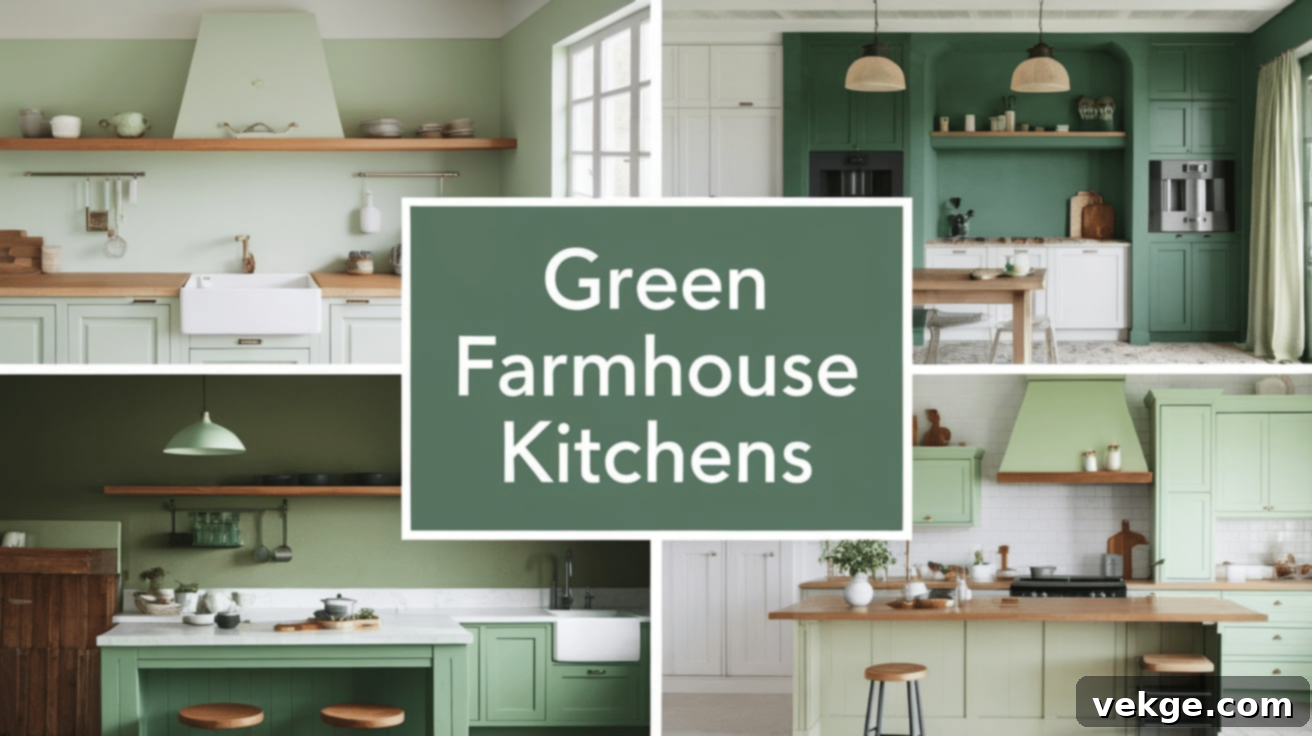The Ultimate Guide to Designing Your Dream Green Farmhouse Kitchen: Ideas, Tips, and Budget Solutions
Imagine a kitchen that instantly evokes warmth, tranquility, and timeless charm. A space where natural elements meet classic design, creating an inviting atmosphere for cooking, gathering, and making memories. This is the magic of a green farmhouse kitchen. Combining the calming essence of green with the rustic elegance of farmhouse style, this design trend brings a fresh, yet deeply rooted character to any home. Whether you’re drawn to soft, subtle hues or bold, dramatic tones, green offers a versatile palette that harmonizes beautifully with wood accents, vintage details, and modern conveniences.
This comprehensive guide will walk you through everything you need to know about designing a beautiful and practical green farmhouse kitchen. From selecting the perfect shade of green to budget-friendly transformations and essential decor ideas, we’ll help you craft a kitchen that feels both stylish and uniquely yours.
Why Choose a Green Farmhouse Kitchen?

A green farmhouse kitchen offers a perfect blend of fresh vitality and classic comfort. The color green is inherently linked to nature, growth, and serenity, making it an ideal choice for a space meant to feel both lively and calming. Its natural appeal allows it to seamlessly integrate the outdoors with your indoor living space, creating a haven that feels cozy, welcoming, and endlessly refreshing.
One of the most compelling reasons to choose green is its remarkable versatility. Green beautifully complements the core materials of farmhouse style, such as natural wood, rugged stone, and classic metals. Whether you have warm wooden cabinets, a sturdy butcher block countertop, or stylish black metal hardware, green effortlessly blends with these elements, making your kitchen feel cohesive and thoughtfully designed. It has the unique ability to highlight the character of these materials, enhancing their texture and natural beauty.
Furthermore, green provides a balanced aesthetic. It’s bright enough to infuse freshness and energy into the room, yet soft enough to maintain that quintessential farmhouse beauty without overwhelming the senses. Unlike fleeting trends, green possesses a timeless quality that ensures your kitchen will remain inviting and stylish for years to come. If your vision is a kitchen that feels deeply homey, slightly rustic, and always welcoming, a green farmhouse kitchen is an outstanding choice that offers both enduring appeal and a soothing ambiance.
Choosing the Right Shade of Green for Your Farmhouse Kitchen
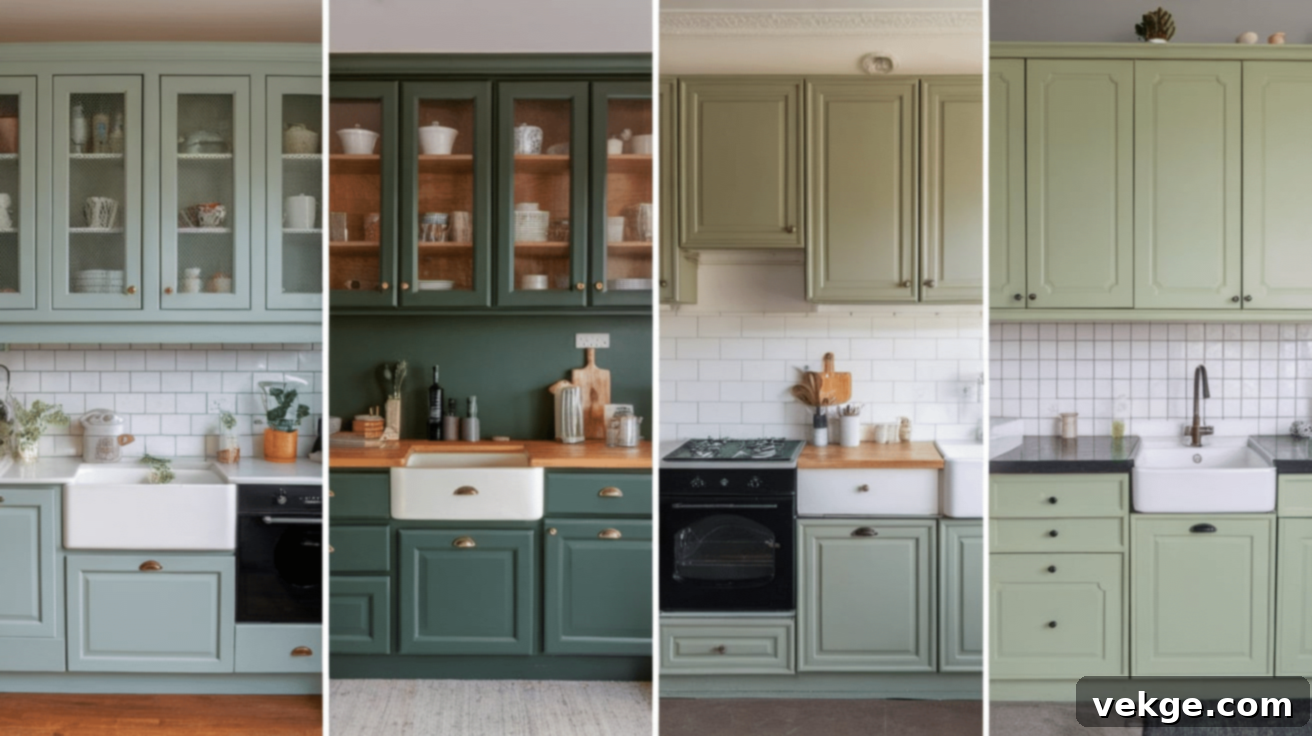
The specific shade of green you select can dramatically alter the mood and character of your farmhouse kitchen. Some greens radiate softness and airiness, while others exude boldness and drama. The secret lies in finding a hue that perfectly harmonizes with your space, lighting conditions, and personal aesthetic. Here are some popular options and their unique qualities:
- Soft Sage: This gentle, grayish-green is the epitome of calm and subtlety. It’s ideal for creating a tranquil and airy atmosphere, particularly in smaller kitchens or spaces abundant with natural light. Sage green pairs beautifully with light woods, white accents, and minimalist farmhouse decor, offering a modern twist on the classic style.
- Deep Forest Green: For a more dramatic and sophisticated statement, deep forest green is an excellent choice. This rich, profound green adds depth and elegance, creating a cozy and luxurious feel. It looks stunning when paired with warm wood tones, brass or gold accents, and vintage-style lighting, enhancing a truly classic farmhouse aesthetic.
- Muted Olive or Moss Green: These warm, earthy greens bring a sense of natural authenticity and organic charm to your kitchen. They resonate with rustic and traditional farmhouse elements, pairing exceptionally well with distressed wooden shelves, antique decor, and natural stone. Olive or moss greens evoke a comforting, lived-in feel.
- Mint or Pastel Green: If you desire a brighter, more cheerful, and whimsical farmhouse kitchen, opt for a soft mint or pastel green. These lighter shades inject a fresh, airy, and youthful vibe into the space. They are perfect for creating a light-hearted, cottage-core farmhouse look, especially when combined with white, floral patterns, or light wood.
- Emerald or Teal Green: For those seeking a vibrant and slightly opulent farmhouse style, emerald or teal greens can add an unexpected pop of color. These jewel-toned greens create a focal point and can be balanced with neutral tones and metallic accents for a refined yet rustic appeal.
Before making your final decision, consider your kitchen’s lighting. Lighter greens can make smaller spaces feel more expansive and open, while darker greens can add a sense of intimacy, warmth, and grounded sophistication to larger areas. Always test swatches on your walls to see how the color changes throughout the day with varying light conditions.
Key Features of a Green Farmhouse Kitchen
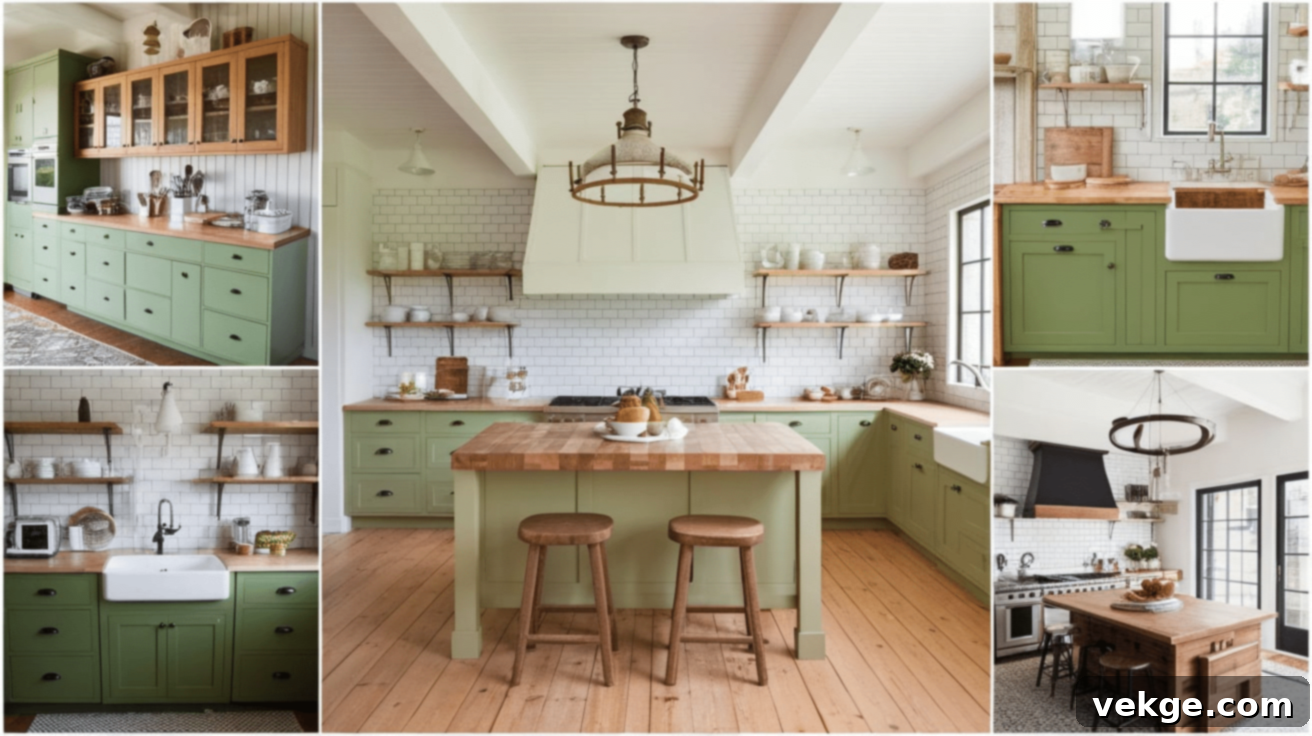
A well-designed green farmhouse kitchen masterfully combines aesthetic appeal with practical functionality. Achieving this signature look involves a careful selection and integration of various key elements:
- Cabinetry: Painted green cabinets are often the star of a farmhouse kitchen. Shaker-style cabinets are a popular choice, offering clean lines that complement both traditional and modern farmhouse sensibilities. You can opt for all-green cabinets for a cohesive look, or mix green base cabinets with natural wood or white upper cabinets for a dynamic, two-tone effect. Distressed finishes can also add to the rustic charm.
- Countertops: The right countertop material can enhance the green palette beautifully. Wooden or butcher block countertops are quintessential farmhouse, adding incredible warmth and a tactile, rustic feel. They develop a beautiful patina over time, contributing to the lived-in charm. For a more durable or refined look, quartz or marble countertops can introduce a touch of modern elegance while still complementing the green hues. Lighter quartz with subtle veining can provide a bright contrast.
- Backsplash: A simple white subway tile backsplash is a timeless and versatile choice that pairs seamlessly with any shade of green, offering a crisp, clean contrast. For added texture and character, consider brick-style tiles, which bring an industrial-farmhouse edge, or patterned tiles with subtle floral or geometric designs to introduce visual interest and a unique personality. Hand-painted zellige tiles can also add an artisanal, organic touch.
- Floors: Hardwood floors are almost a prerequisite for an authentic farmhouse kitchen, providing warmth, durability, and a natural foundation. Light to medium wood tones work exceptionally well with green, contributing to an inviting and expansive feel. If tiles are preferred, opt for large-format neutral shades like beige, cream, or light gray porcelain tiles, or even traditional terracotta for a more rustic, Mediterranean-inspired farmhouse look.
- Hardware & Fixtures: The details make a significant difference. Choose simple, vintage-style hardware such as matte black pulls and knobs for a modern farmhouse contrast, warm brass for a touch of elegance and vintage flair, or antique silver/pewter for a more traditional, subdued look. Beyond cabinet hardware, select farmhouse-style light fixtures like classic pendants over an island, lantern-style sconces, or a rustic chandelier to truly complete the aesthetic and provide ambient lighting. A farmhouse-style sink (apron front) is also a highly functional and visually appealing feature.
By thoughtfully combining these essential elements, you can craft a green farmhouse kitchen that is not only stylish and aesthetically pleasing but also highly functional and deeply inviting. The careful selection of green tones, paired with complementary materials, brings an undeniable cozy charm to the heart of your home.
Budget-Friendly Ways to Achieve a Green Farmhouse Kitchen
Dreaming of a green farmhouse kitchen doesn’t have to mean a complete financial overhaul. Many affordable strategies can help you infuse this beautiful style into your home without breaking the bank. With a little creativity and DIY spirit, you can achieve a stunning transformation.
1. Paint Your Cabinets
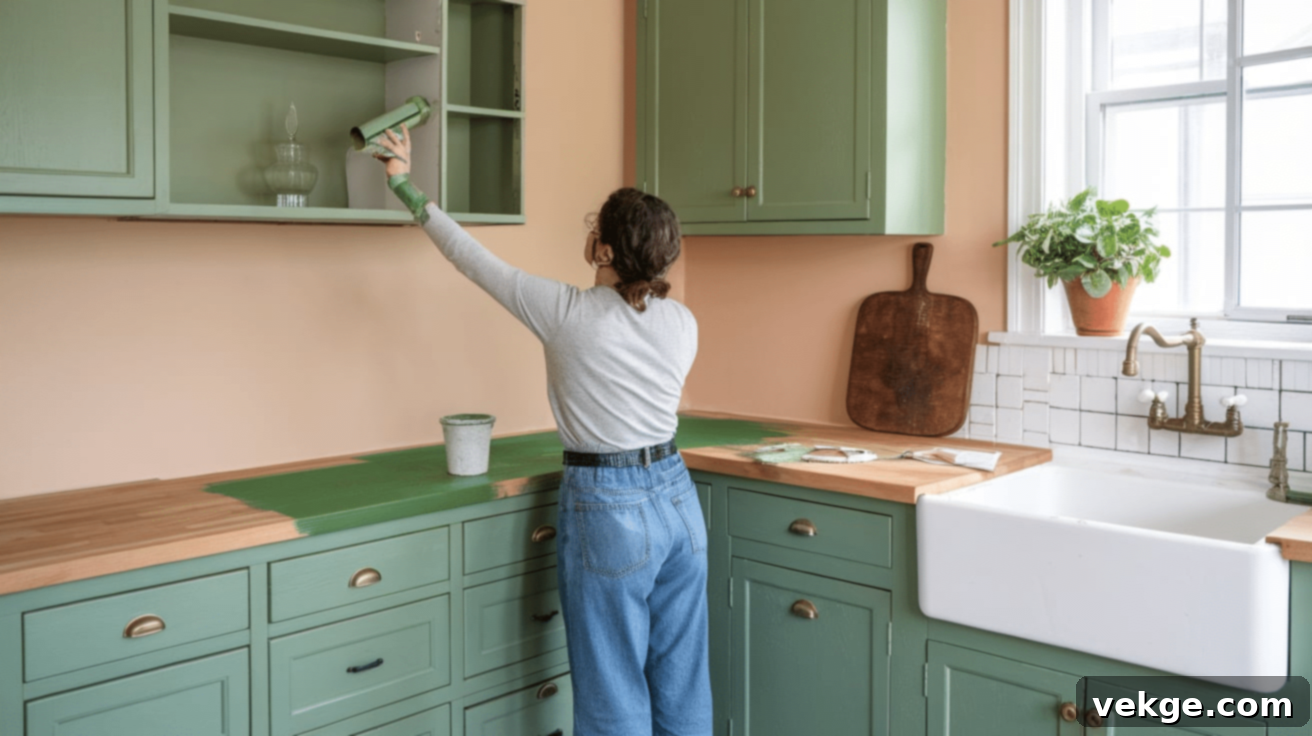
One of the most impactful and cost-effective ways to update your kitchen is to paint your existing cabinets. Instead of the significant expense of replacing them, a fresh coat of green paint can entirely transform the look and feel of your space. Select a charming green shade like soft sage, olive, or even a muted forest green to instantly achieve that coveted farmhouse aesthetic. You can paint all cabinets for a cohesive look, or choose to paint just the lower cabinets green and keep the uppers white for a popular two-tone design that adds visual interest and a sense of lightness.
2. Use Peel-and-Stick Backsplash Tiles
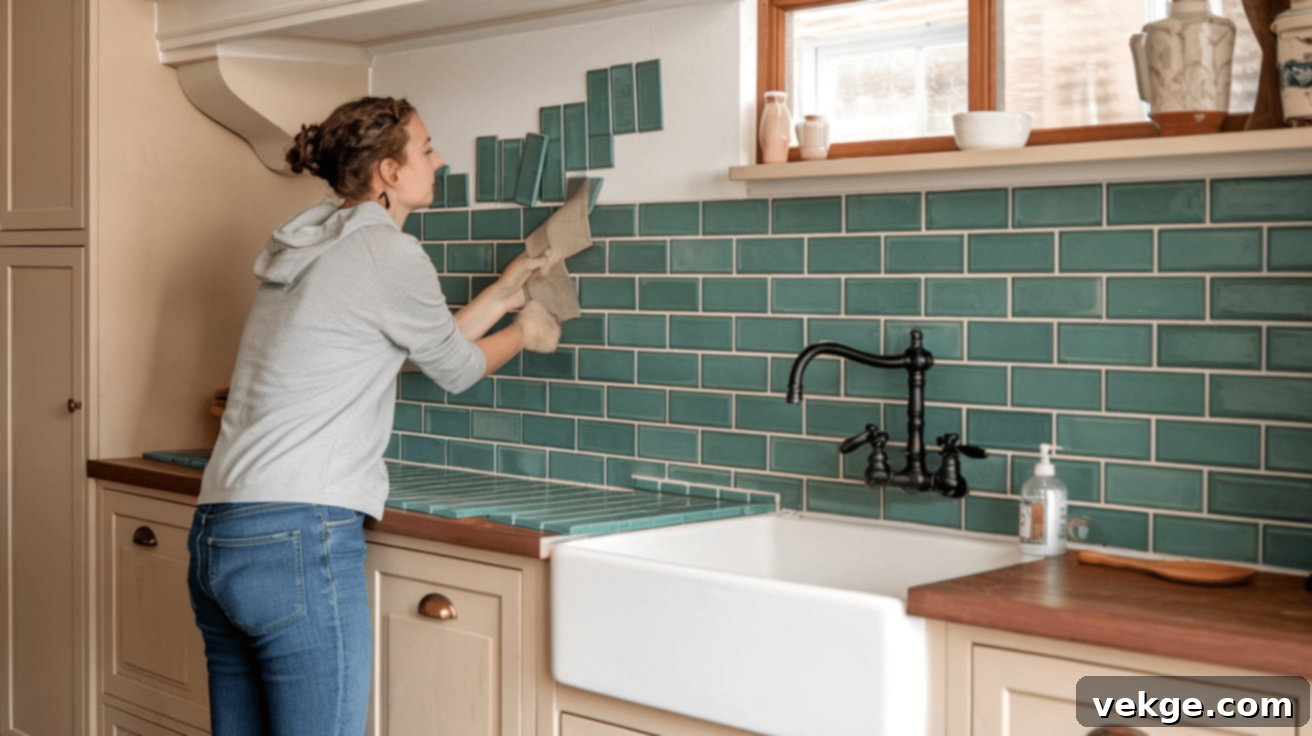
Installing a traditional tile backsplash can be costly and labor-intensive. Fortunately, peel-and-stick tiles offer a fantastic, budget-friendly alternative. These adhesive tiles come in a wide array of farmhouse-friendly designs, including classic white subway tiles, rustic brick patterns, and even subtle patterns that mimic more expensive materials. They are incredibly easy to install, requiring no grout or special tools, making them perfect for a quick and affordable kitchen refresh. You can even find options with green tones or patterns to complement your chosen green palette.
3. Repurpose Furniture and Decor
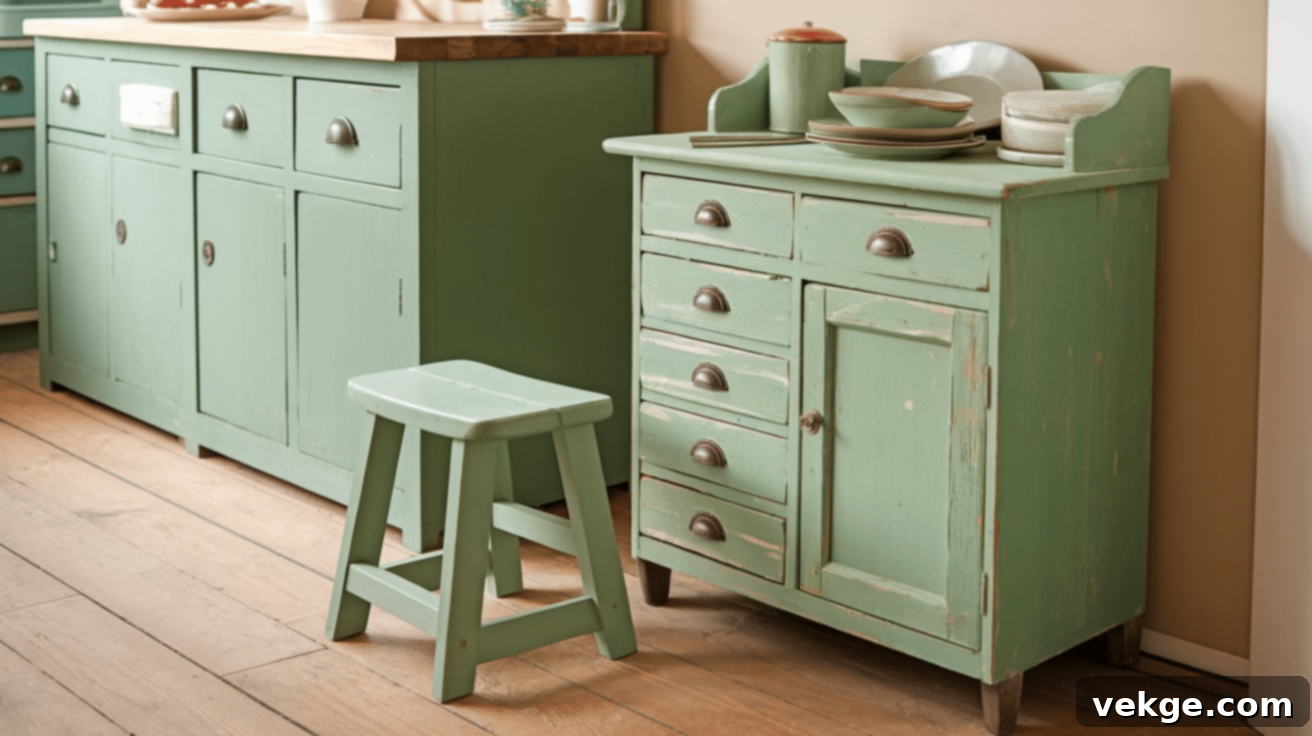
Embrace the hunt! Thrift stores, flea markets, antique shops, and garage sales are treasure troves for inexpensive farmhouse-style furniture and decor. Look for old tables, chairs, hutches, or shelves that can be easily painted, sanded, or refinished to match your green farmhouse theme. For example, a vintage wooden table can be given a new lease on life with a fresh coat of green or a complementary neutral paint, perhaps with some deliberate distressing to enhance its rustic charm. Old crates can be repurposed into stylish storage, and antique kitchen tools can become charming wall art.
4. Add Greenery
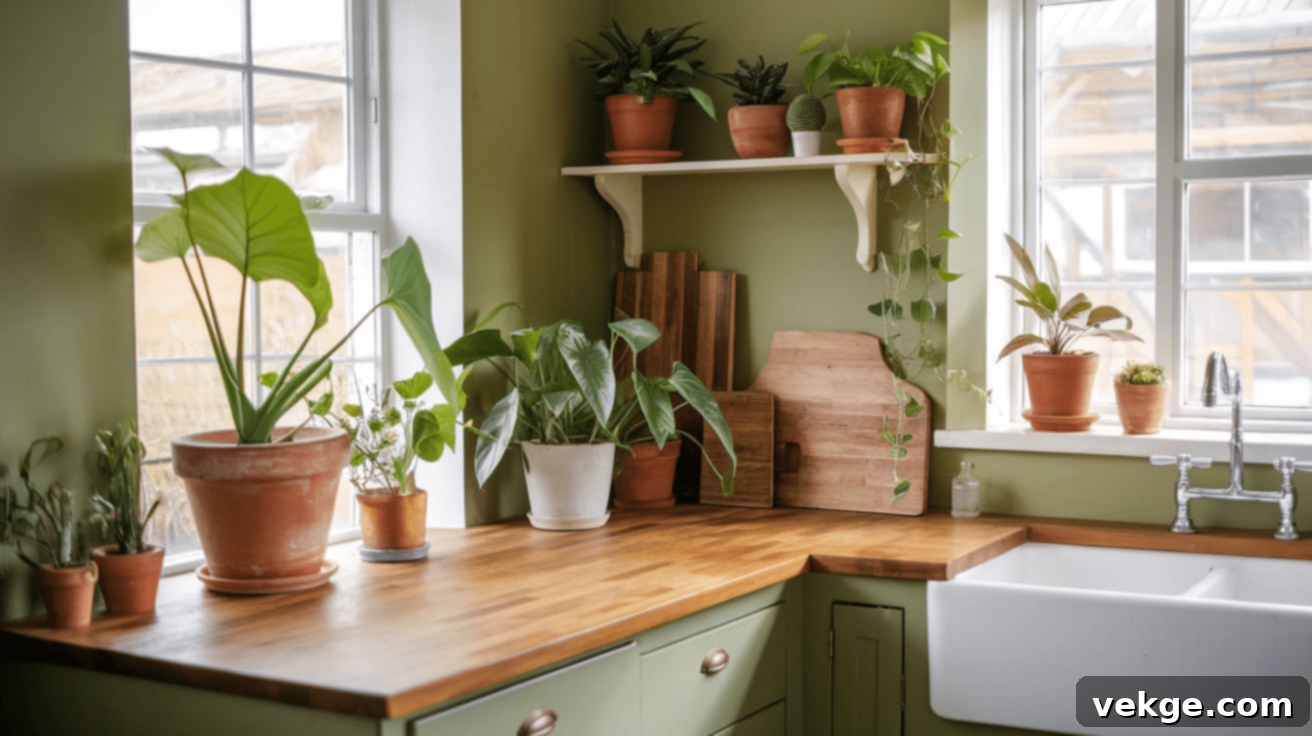
Plants are an incredibly affordable and effective way to inject life, freshness, and a natural touch into your kitchen. Grow your favorite herbs in small terracotta or ceramic pots on your windowsill, or hang trailing plants from shelves or the ceiling to create a lush, organic look. If you don’t have a green thumb, high-quality artificial plants can work just as well and require no maintenance. Opt for simple planters, mason jars, or rustic ceramic pots to maintain the farmhouse aesthetic. The addition of living (or faux) plants truly helps to “bring the outdoors in,” enhancing the calming green theme.
5. Choose Budget-Friendly Countertops
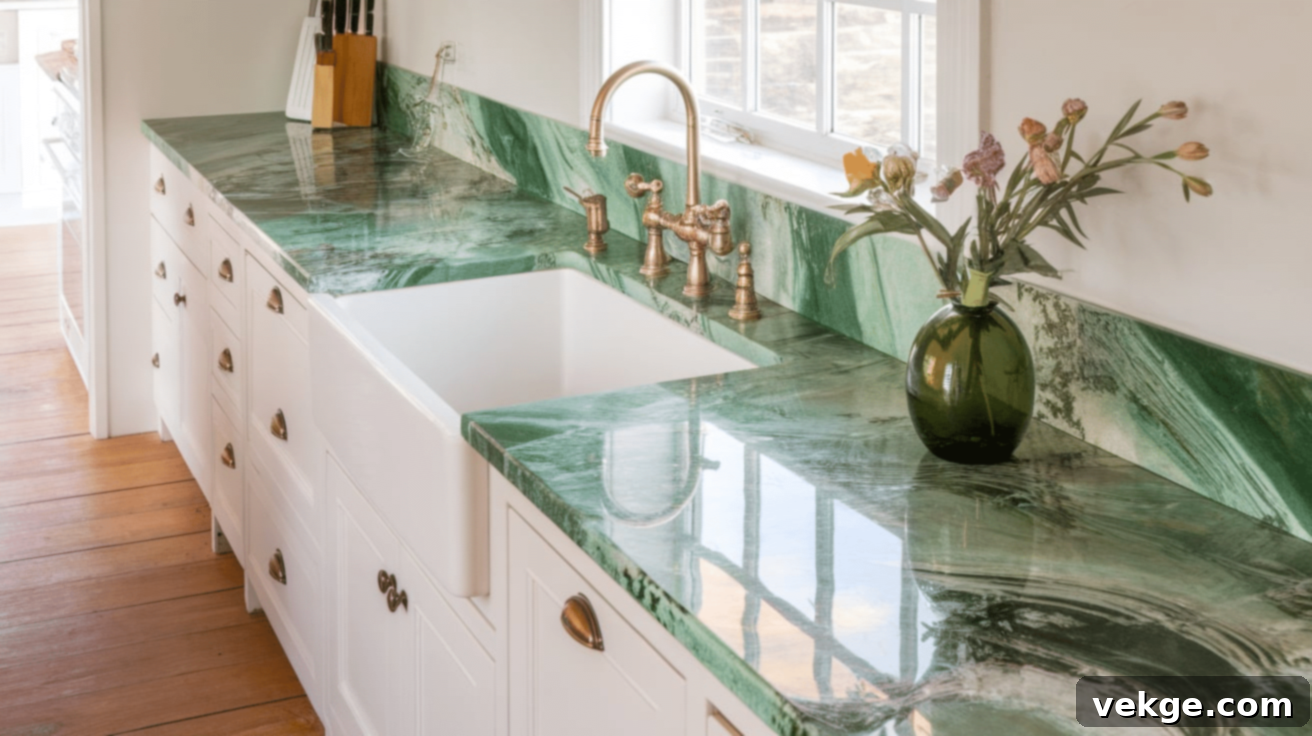
Countertops often represent a significant portion of a kitchen renovation budget. However, there are numerous cheaper options that still look fantastic with green farmhouse cabinets. Butcher block countertops, for instance, are both affordable and offer a natural, warm, and distinctly rustic look that is perfect for a farmhouse kitchen. Laminate countertops have also come a long way, with many designs now mimicking the appearance of marble, granite, or wood at a fraction of the cost. If you’re seeking a more contemporary feel without the high price tag, some affordable quartz options can provide a sleek, durable surface.
6. Update the Hardware
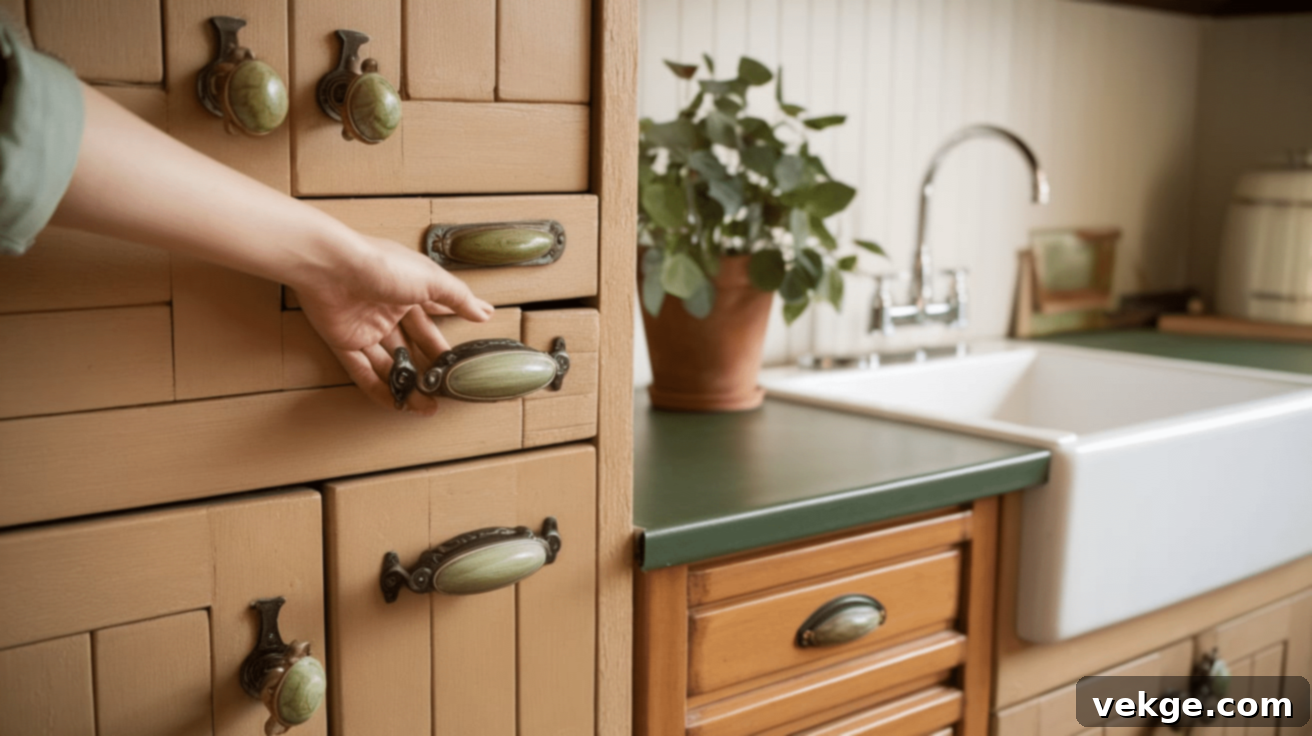
Swapping out your cabinet knobs and pulls is a surprisingly quick, easy, and inexpensive way to give your kitchen a refreshed look. Seek out vintage-style hardware in finishes like matte black, antique brass, oil-rubbed bronze, or simple wooden pulls. You don’t need to splurge on high-end hardware; even small, thoughtful changes like this can significantly impact the overall feel and character of your green farmhouse kitchen, tying the whole look together.
By implementing these clever and budget-friendly tips, you can transform your kitchen into the inviting green farmhouse space you’ve always envisioned, all while keeping your finances in check.
Green Farmhouse Kitchen Decor Ideas
Decorating your green farmhouse kitchen is an enjoyable opportunity to inject personality, warmth, and a touch of curated charm into your space. It’s all about layering textures, bringing in natural elements, and embracing vintage finds. Here are some inspiring ideas to help you cultivate that cozy, authentic farmhouse feel:
1. Open Shelving

Open shelving is a hallmark of farmhouse design, offering both practical storage and a display opportunity. Install rustic wooden shelves (reclaimed wood works wonders) to showcase your favorite white dishes, stacks of vintage-inspired bowls, mason jars filled with dry goods, or charming antique finds. This not only makes the kitchen feel more spacious and inviting but also allows you to infuse your personal style. Add small potted herbs, trailing plants, or a collection of ceramic mugs for a fresh, curated look.
2. Farmhouse Lighting
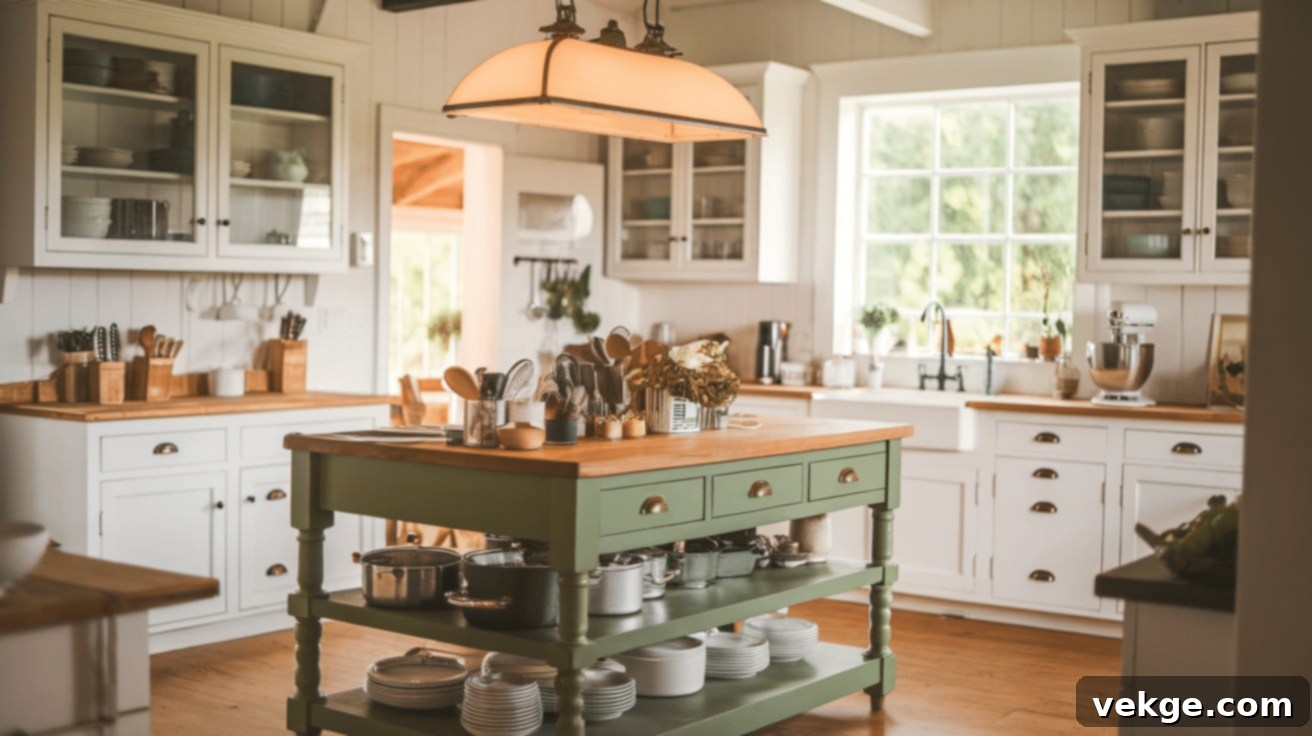
Lighting plays a crucial role in setting the right mood. Opt for farmhouse-style fixtures such as industrial-inspired pendant lights hanging over an island or dining area, or classic lantern-style sconces on the walls. These fixtures provide ample light while contributing to the rustic aesthetic. For an extra layer of warmth and ambiance, consider adding under-cabinet lighting or even draped string lights for a soft, inviting glow during evening hours.
3. Vintage Accessories
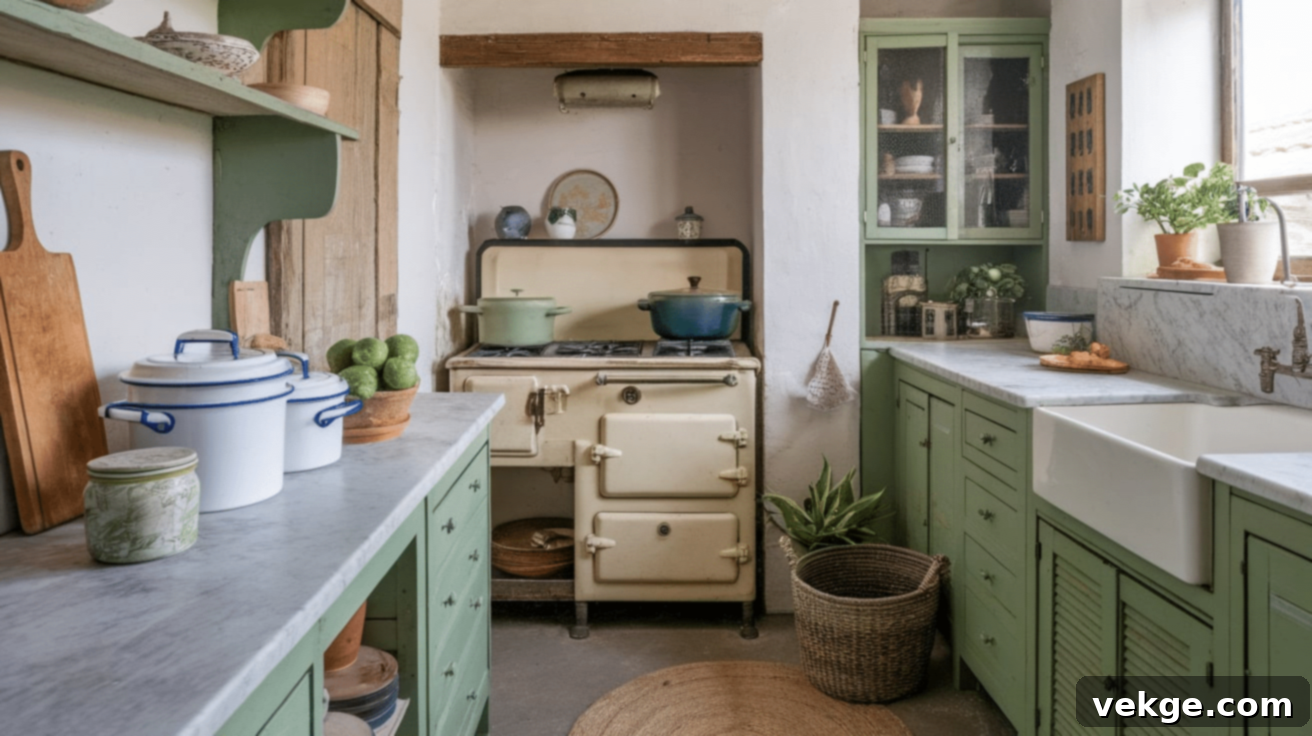
Infuse your kitchen with character by incorporating vintage accessories. Hunt for old enamelware (coffee pots, pitchers), collections of varied mason jars, antique kitchen scales, or classic wooden cutting boards. These pieces add a sense of history and give your kitchen a cherished, lived-in feel. Consider displaying vintage signs with charming sayings, old cookbooks, or unique kitchen utensils on hooks to enhance the farmhouse appeal and add personal touches.
4. Textiles
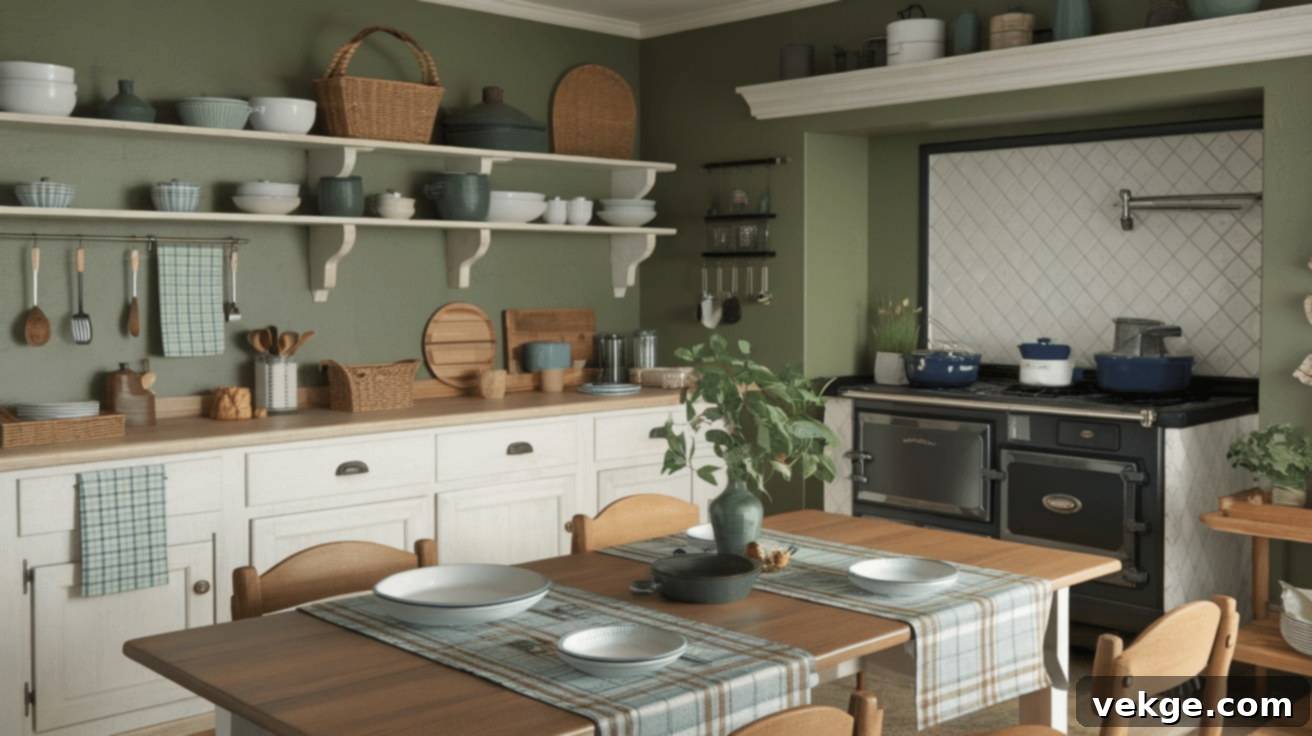
Soft textiles are essential for adding comfort, color, and texture to your kitchen. Incorporate plaid or striped dish towels, linen tablecloths or runners, and comfortable seat cushions on stools or dining chairs. Look for fabrics made from natural fibers like cotton, linen, or burlap to maintain a cozy and casual feel. These materials not only look aesthetically pleasing but also feel soft to the touch, making your kitchen an even more inviting space. A braided rug or a woven mat can also define an area and add warmth underfoot.
5. Rustic Utensils and Storage
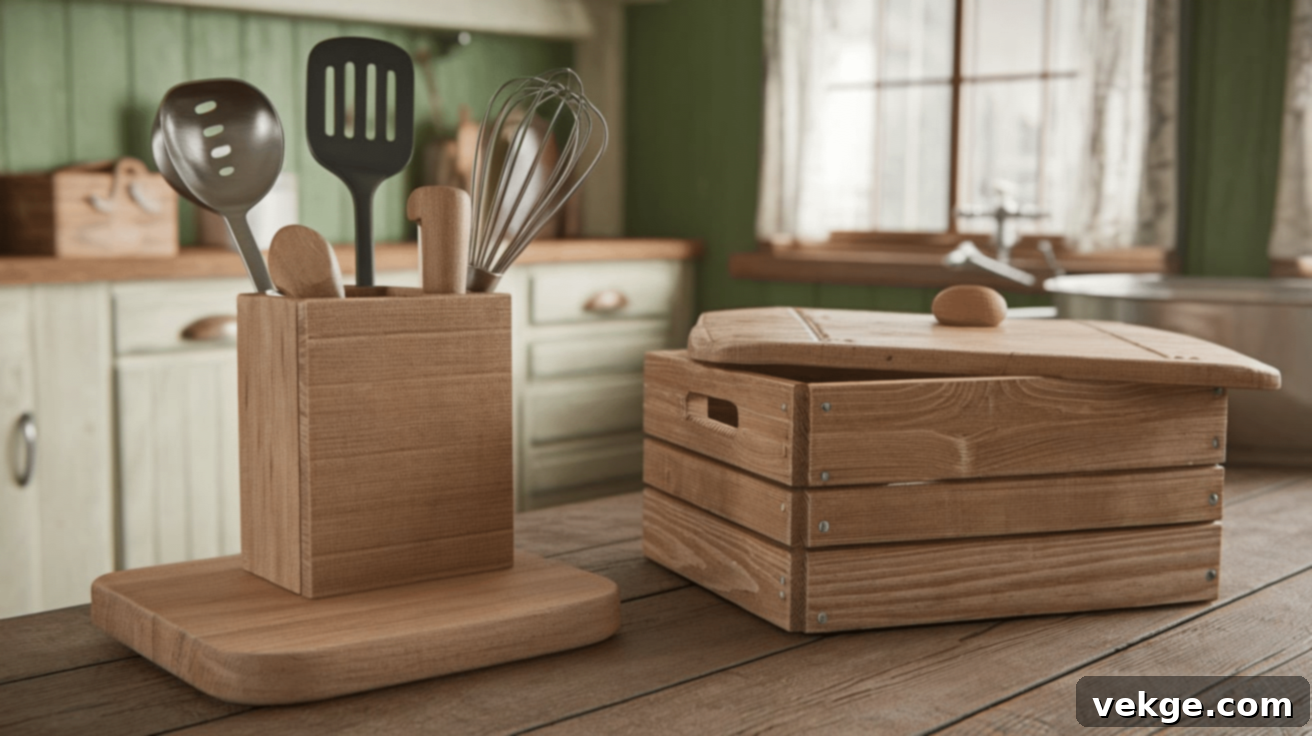
Blend functionality with style by using rustic storage solutions for everyday items. Mason jars are perfect for storing dried goods, spices, or for holding utensils on the countertop. Wooden crates or wire baskets can artfully organize produce, napkins, or other kitchen essentials. Not only are these storage ideas practical, but their natural and aged aesthetic perfectly complements the farmhouse theme. You can even label them with vintage-style tags for an extra personalized touch, enhancing the overall charming and organized look of your kitchen.
6. Farmhouse Wall Art
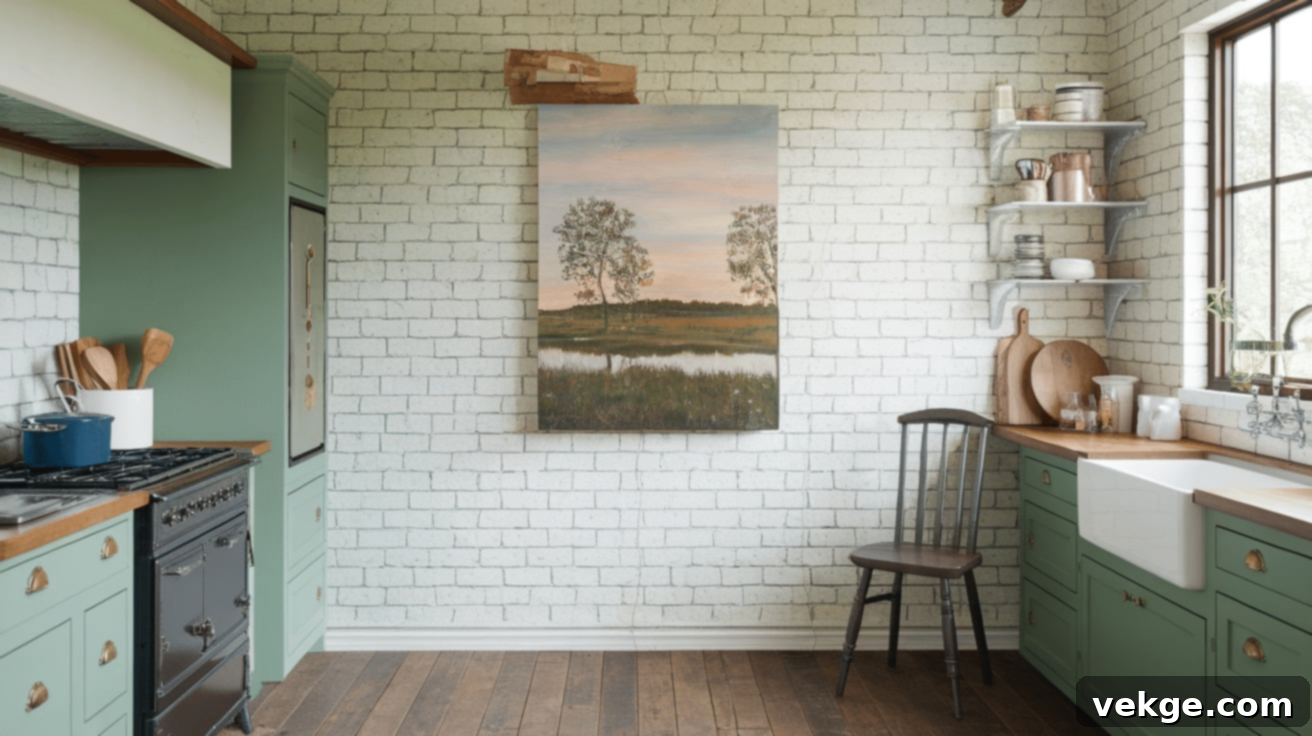
Adorn your kitchen walls with art that resonates with the farmhouse style. Framed botanical prints, vintage advertisements, a rustic chalkboard for menus or grocery lists, or simple wooden signs bearing sweet sayings can add significant character. Consider hanging a large farmhouse-style clock, a collection of antique cutting boards, or old kitchen tools arranged creatively for a unique gallery wall. These decorative pieces contribute to a welcoming atmosphere, making your kitchen feel more like a cherished home.
7. DIY Projects
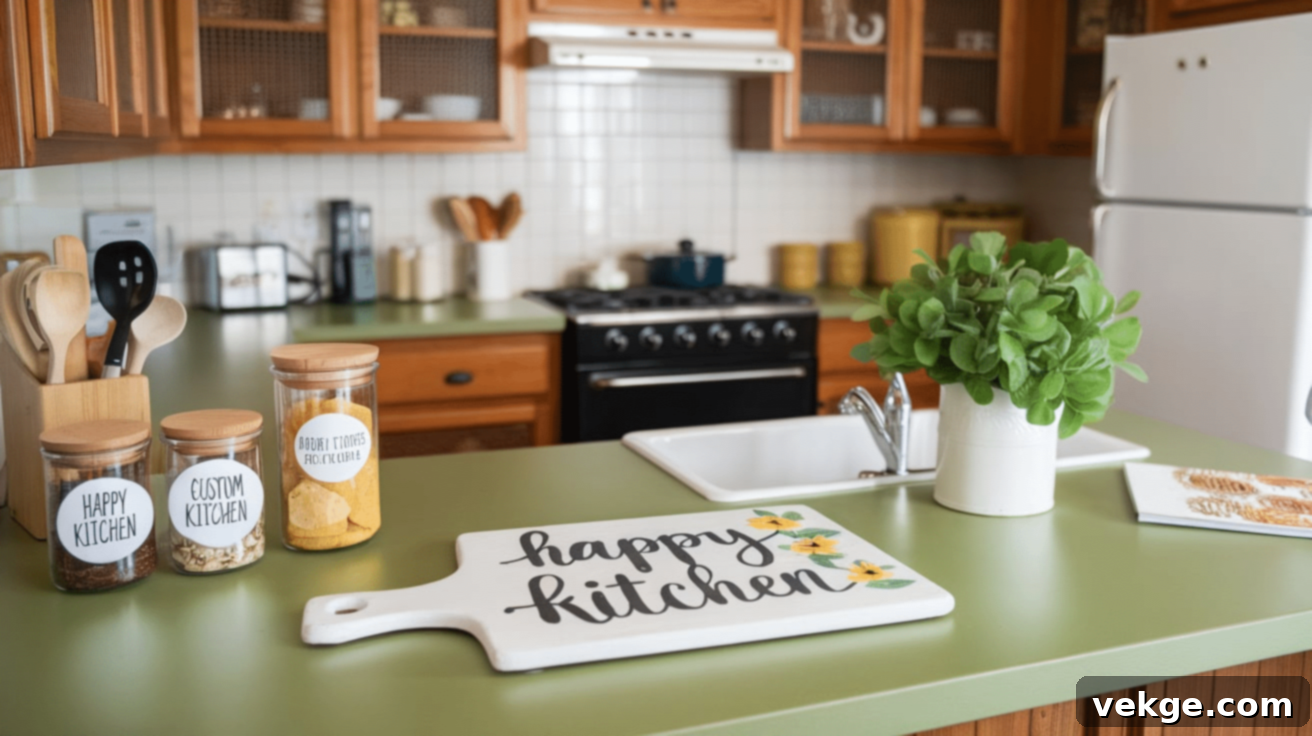
If you enjoy hands-on projects, embrace the DIY spirit to craft unique farmhouse decor. A homemade wooden sign with a hand-painted phrase, a personalized cutting board, or custom labels for your pantry jars can add a deeply personal touch that is both functional and stylish. You could also paint old crates for extra storage, stencil designs onto plain textiles, or create a rustic herb garden box. DIY projects allow you to customize your decor perfectly to your kitchen’s specific look and give it an irreplaceable, personal feel, reflecting your dedication to creating a unique space.
With these diverse decor ideas, your green farmhouse kitchen will be brimming with warmth, beauty, and authentic personality. The goal is to create a cozy, welcoming space where every element contributes to a harmonious and memorable experience for cooking, gathering, and living.
How to Mix Green with Other Farmhouse Colors?
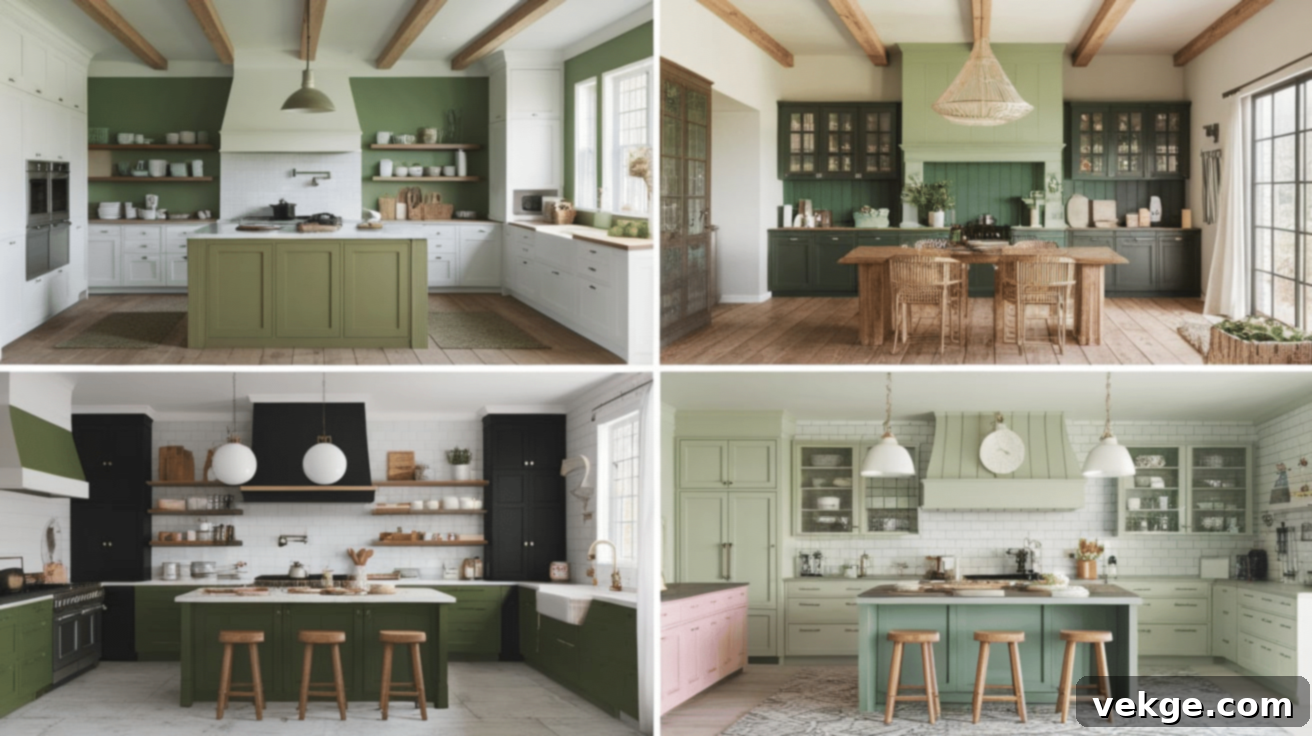
Green is an incredibly versatile color, offering a natural foundation that pairs beautifully with a wide spectrum of other farmhouse tones. Whether your aim is a soft, serene ambiance or a bold, dramatic statement, carefully combining green with complementary colors can help you curate the perfect farmhouse kitchen aesthetic.
Here are some harmonious color combinations to inspire your design:
1. Green and White: This is a classic and perpetually popular farmhouse combination. The crispness of white provides a clean contrast that balances out the richness of green, making the space feel incredibly fresh, bright, and open. You can use white for walls, upper cabinets, backsplashes, or trim, and introduce green through lower cabinets, an island, or various decor accents.
2. Green and Wood Tones: Wood is an indispensable element of farmhouse style, and it looks absolutely magnificent alongside green. Pairing a soft sage green with natural, light-toned wood floors or butcher block countertops creates an exceptionally warm, inviting, and organic atmosphere. Darker, richer wood tones, such as walnut or mahogany, can be beautifully contrasted with a deep forest green for a more sophisticated and grounded feel, bringing out the depth in both colors.
3. Green and Black: For a striking and modern farmhouse look, consider the sophisticated combination of green and black. Black accents, such as matte black light fixtures, cabinet hardware, a black farmhouse sink, or even dark window frames, truly pop against green cabinets or walls. This pairing creates a bold visual statement, adding an edge of contemporary industrial style to the classic farmhouse aesthetic.
4. Green and Brass/Gold: Introduce a touch of vintage elegance and warmth by pairing green with brass or gold. Brass light fixtures, cabinet knobs, drawer pulls, or faucets can look exquisitely beautiful and luxurious against green cabinets, a green feature wall, or even green countertops. The warm, metallic glow of brass perfectly complements the cool undertones of many greens, creating a refined and welcoming atmosphere.
5. Green and Neutrals (Beige, Gray, Cream): Green integrates seamlessly with a palette of neutral colors like beige, light gray, or creamy off-white. These combinations create a soft, earthy, and highly calming aesthetic. You can use neutral colors for larger surfaces like walls, flooring, or major furniture pieces (e.g., a dining table), and then introduce green through cabinet paint, textiles, plants, or smaller decorative accessories. This allows the green to subtly anchor the space without being overwhelming.
6. Green and Soft Pastels: For a light, airy, and slightly whimsical farmhouse kitchen, experiment with mixing green with other soft pastel shades such as light blue, pale yellow, or gentle pink. These combinations evoke a cheerful and delicate vibe, perfect for a cottage-style or shabby chic farmhouse kitchen. Use pastels in smaller doses, perhaps in dish towels, decorative plates, or floral arrangements.
7. Green and Red (Accent): If you wish to inject a touch of traditional country charm into your farmhouse kitchen, green and red can work wonderfully together, especially when red is used sparingly as an accent. Think of a classic red checkered tablecloth, small red berries in a vase, or hints of red in vintage signs. This combination adds a cozy, inviting, and nostalgic feeling, particularly around holidays or as a seasonal touch.
By thoughtfully mixing green with these complementary farmhouse colors, you can craft a balanced, visually appealing, and deeply personalized kitchen. Whether you opt for striking contrasts or subtle, harmonious blends, the right combination of colors will infuse your space with warmth, distinctive style, and undeniable beauty, making it a true centerpiece of your home.
Essential Tips for a Perfect Green Farmhouse Kitchen
Creating the ideal green farmhouse kitchen involves a careful balance of aesthetics, functionality, and personal touch. To ensure your kitchen is not only beautiful but also a joy to live and work in, consider these essential tips:
1. Balance the Green Thoughtfully: While green is the star, too much of a single color can sometimes feel overwhelming. Balance your chosen green hue with plenty of neutral colors like crisp white, calming gray, or warm beige. For instance, if your cabinets are green, opt for lighter tones on your countertops, backsplash, or walls. A good rule of thumb is to use the 60-30-10 principle: 60% neutral primary color, 30% green, and 10% accent color.
2. Mix Different Textures: The farmhouse style thrives on rich textures that add depth and visual interest. Pair your smooth green cabinets with natural, tactile materials such as rustic wood (on shelves, beams, or an island), rough-hewn stone (in a fireplace surround or accent wall), or various metals (in light fixtures, hardware, or appliances). Incorporating different textures prevents the space from feeling flat and enhances its cozy, lived-in appeal.
3. Maximize Natural Light: Green tones, especially lighter shades, truly come alive under natural light. If your kitchen is blessed with large windows, let the sunlight stream in by minimizing heavy window treatments. Natural light will highlight the varying nuances of your green palette and make the space feel more open and airy. For darker kitchens, lighter greens like sage or mint are excellent choices as they reflect light, brightening the room, and consider ample artificial lighting to mimic natural brightness.
4. Add Personal Touches and Stories: Make your green farmhouse kitchen truly yours by infusing it with personal touches that tell your story. Display cherished family photos in rustic frames, showcase your favorite collected dishes or glassware on open shelves, or hang vintage signs that evoke fond memories. These unique elements add character, warmth, and make the space feel genuinely like home, reflecting your personality and history.
5. Include Abundant Greenery: Beyond just the paint color, introduce actual greenery to enhance the natural, fresh feel of your kitchen. Potted herbs on the windowsill, trailing plants hanging from ceiling hooks, or larger floor plants can invigorate the space. Consider green accents in textiles (like patterned dish towels) or decorative objects to tie everything together and reinforce the natural theme.
6. Prioritize Smart Storage Solutions: A functional farmhouse kitchen is an organized one. Incorporate plenty of smart storage solutions to keep clutter at bay. Utilize open shelving for easily accessible and aesthetically pleasing items, and use baskets, crates, or pull-out pantry systems for hidden storage. Consider built-in cabinetry that maximizes vertical space. Ensure your storage choices are both practical for everyday use and complement the overall farmhouse aesthetic, keeping your kitchen looking stylish and tidy.
By thoughtfully applying these tips, you can design a green farmhouse kitchen that is not only inviting and stylish but also perfectly suited for your daily life. It’s about finding the right balance of colors, textures, and personal touches to create a space that feels deeply comfortable, functional, and authentically yours.
Conclusion
A green farmhouse kitchen offers a truly beautiful and harmonious way to infuse warmth, distinctive style, and profound comfort into your home. With its soothing array of green shades, seamlessly blended with natural wood, robust metals, and charmingly simple decor, it creates a cozy and inviting sanctuary that feels both classic and refreshingly modern.
Whether you are captivated by the serene elegance of soft sage, the rich depth of deep forest green, or the cheerful vibrancy of a pastel hue, green proves to be an incredibly versatile color. It pairs effortlessly with a wide range of other farmhouse tones, allowing you to tailor the perfect atmosphere for your culinary haven.
Remember, the essence of a successful green farmhouse kitchen lies in balance and thoughtful execution. Ensure you balance the dominance of green with complementary neutrals, embrace the tactile richness of mixed textures, and prioritize a kitchen that is both highly functional and beautifully organized. Small, carefully chosen touches—such as vintage accessories, an abundance of live plants, and simple, character-rich lighting—will ultimately give the room its unique personality and enduring beauty.
By following the comprehensive ideas and practical tips outlined in this guide, you are well-equipped to design and create a green farmhouse kitchen that is not only aesthetically stunning but also profoundly practical and deeply personal. It’s about crafting a space where you feel completely comfortable, inspired, and truly at home, making every moment spent there a cherished memory.
Frequently Asked Questions About Green Farmhouse Kitchens
How Can I Add Farmhouse Style to My Kitchen without Spending a Lot?
You can achieve a charming farmhouse look on a budget by painting your existing cabinets green, using affordable peel-and-stick backsplash tiles for an instant upgrade, and incorporating vintage or repurposed decor items like mason jars, wooden crates, or antique kitchen tools found at thrift stores. Small updates to cabinet hardware can also make a big impact.
What Materials Work Well with a Green Farmhouse Kitchen?
Natural materials are key to a successful green farmhouse kitchen. Wood (like oak, pine, or butcher block for countertops and shelves), various metals (matte black, brass, antique silver for hardware and fixtures), and natural stone (for countertops or accent walls) pair beautifully with green. These elements enhance the rustic and organic feel of the farmhouse style.
Can I Use Green in a Small Kitchen?
Absolutely! Green can work wonderfully in a small kitchen. Opt for lighter shades such as sage green, mint green, or a pale olive to make the space feel more open, airy, and expansive. Balance the green with plenty of white or other neutral tones on walls, countertops, or open shelving to prevent the room from feeling cramped or dark.
How Do I Organize a Farmhouse Kitchen on a Budget?
Budget-friendly organization for a farmhouse kitchen is easy and charming. Utilize affordable items like mason jars for storing dry goods, spices, or utensils. Wooden crates, wire baskets, and simple fabric bins are excellent for organizing produce, linens, or cleaning supplies. Open shelving allows for accessible storage and display of curated items, while hooks can keep frequently used tools within reach, all while contributing to the farmhouse aesthetic.
Are Green Kitchens a Popular Trend or a Timeless Choice?
While green kitchens have seen a surge in popularity recently, green is largely considered a timeless and classic color choice for interiors. Its connection to nature ensures it has enduring appeal, offering a calming and versatile backdrop that transcends fleeting trends. Especially when paired with traditional farmhouse elements, a green kitchen maintains a classic and inviting atmosphere that won’t go out of style.
